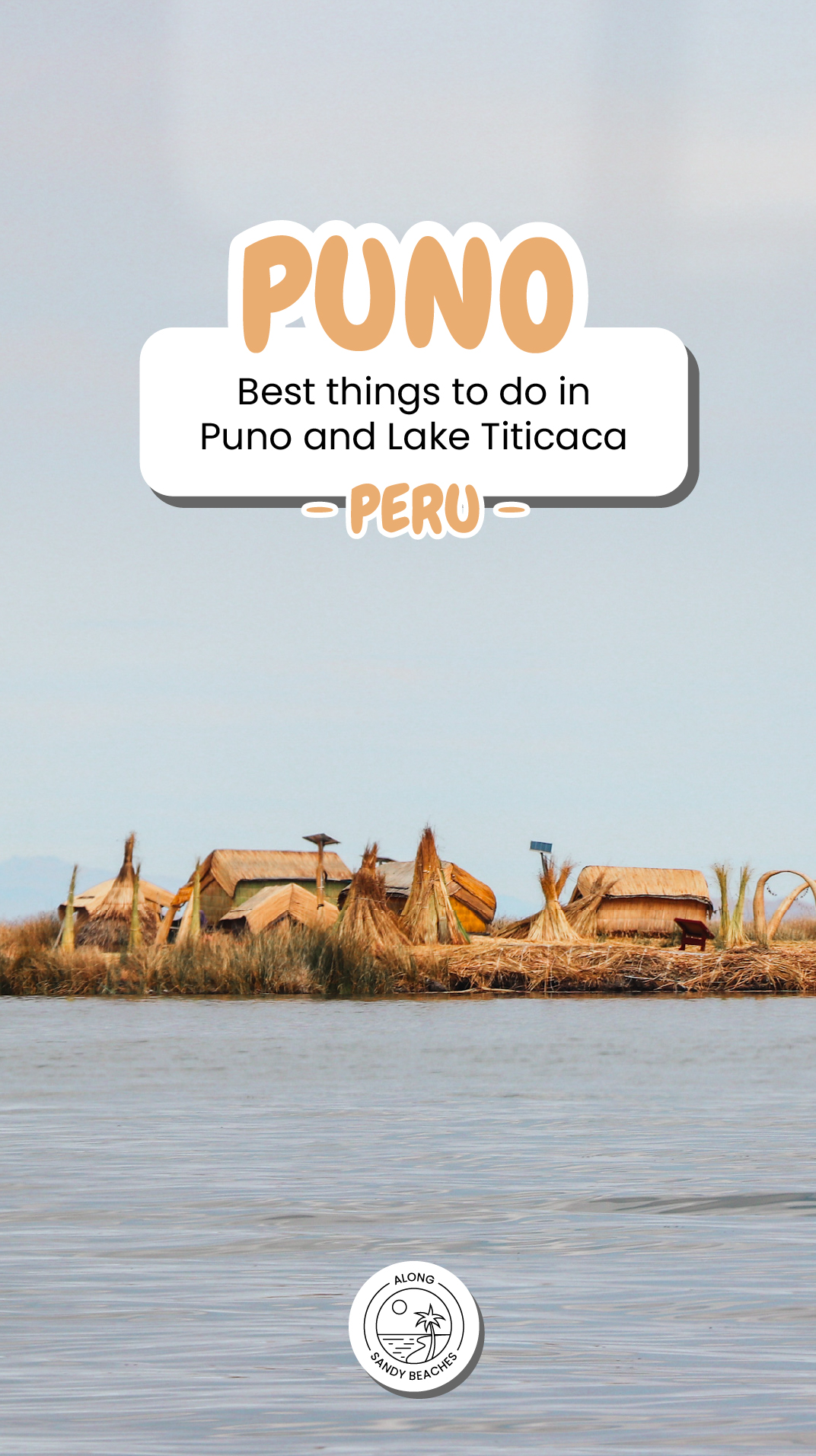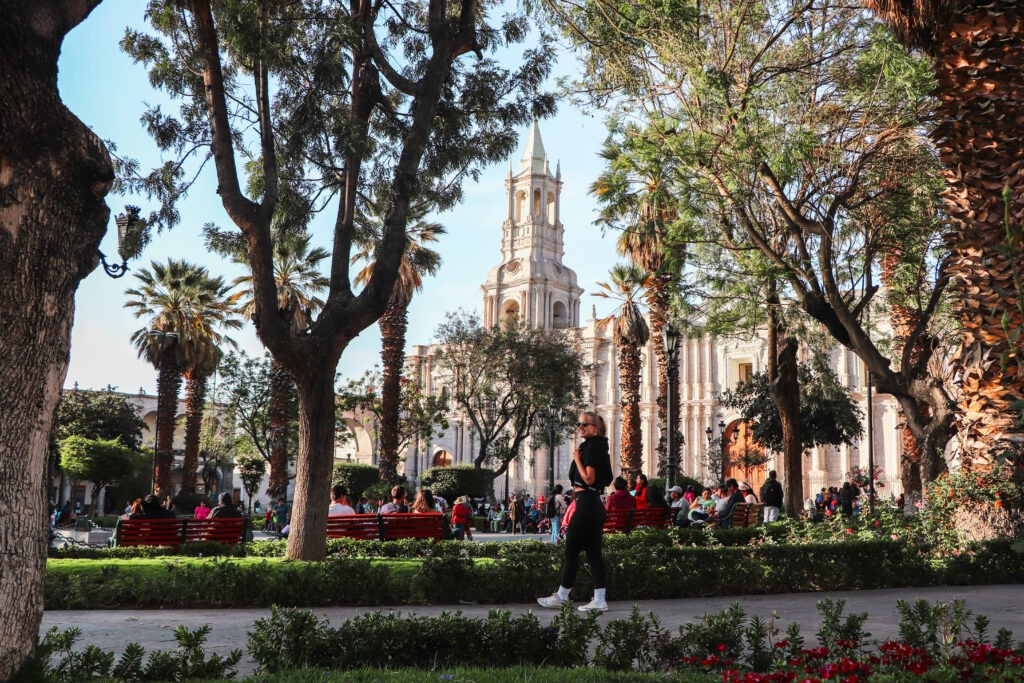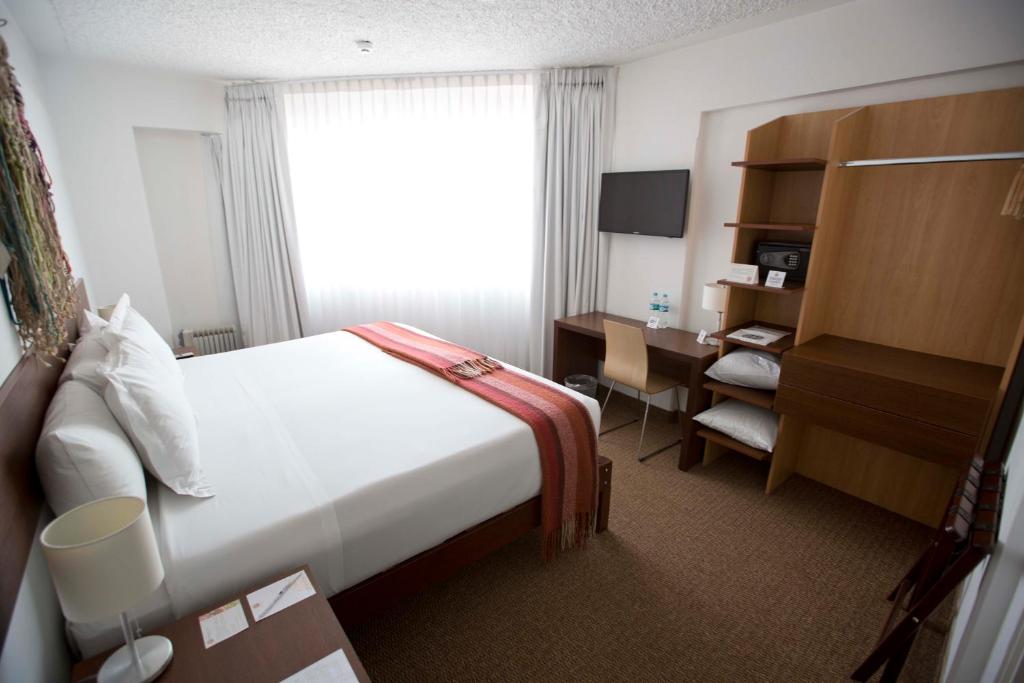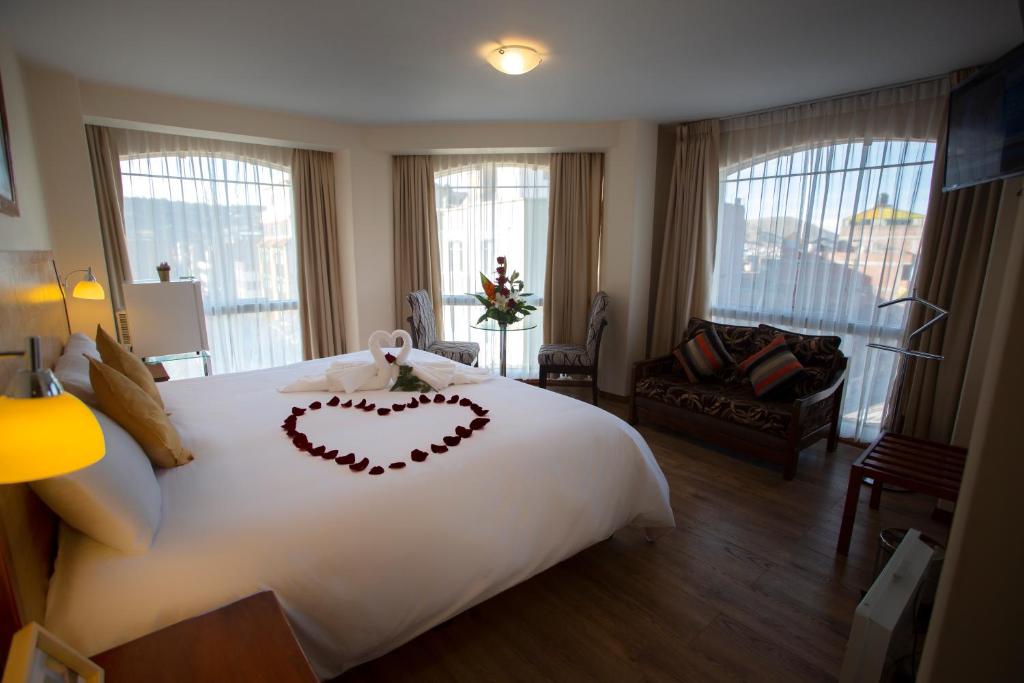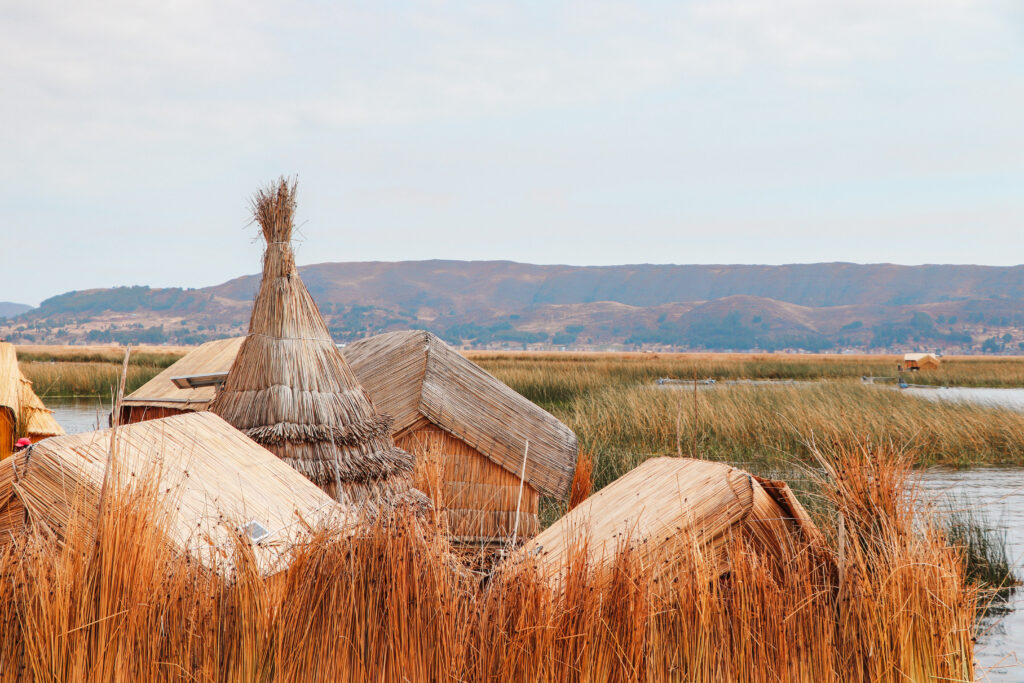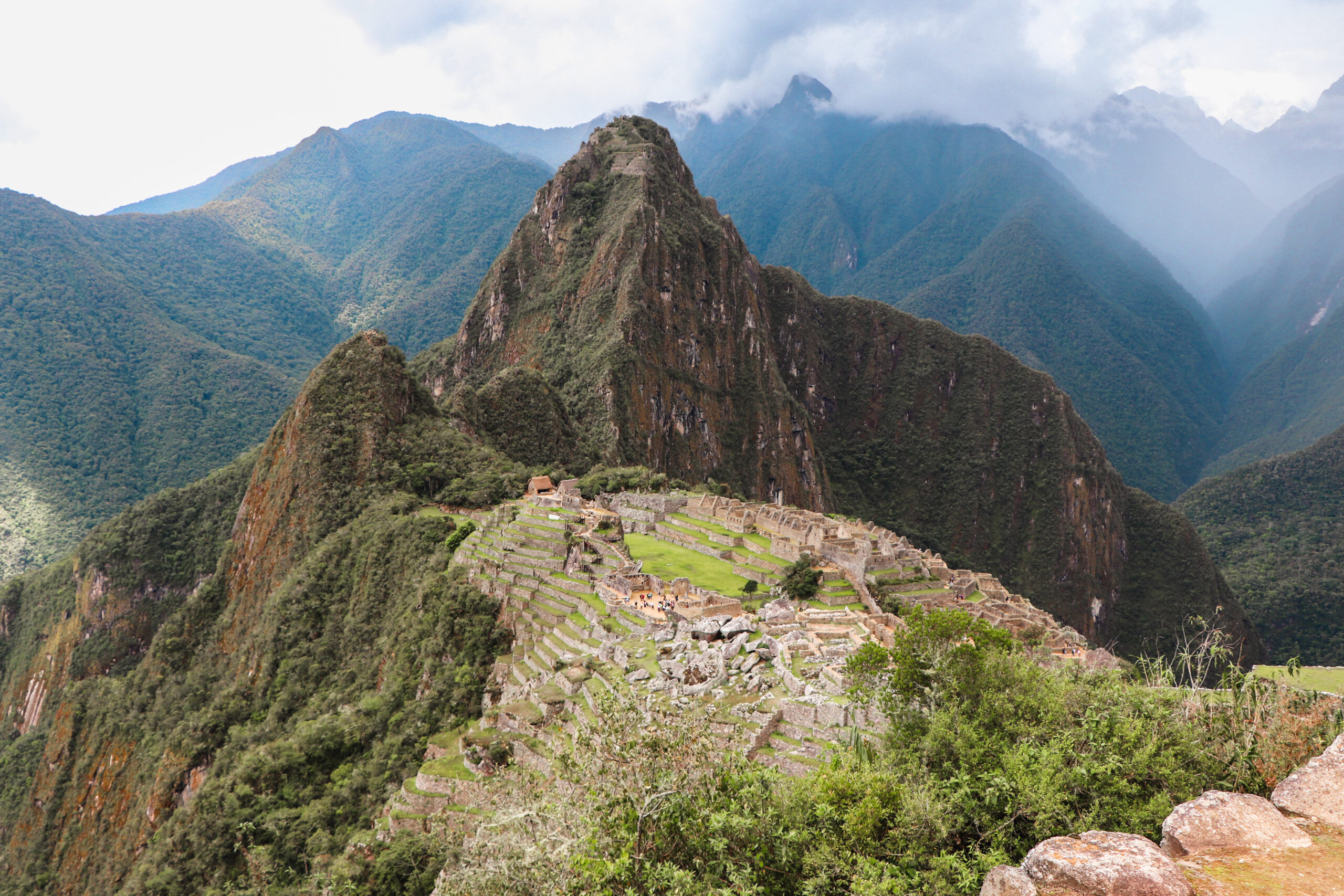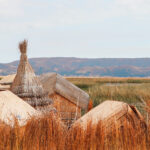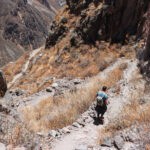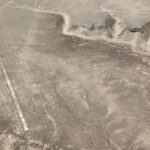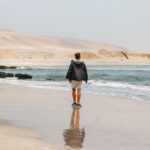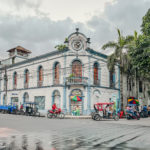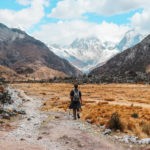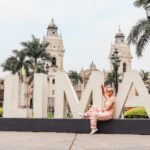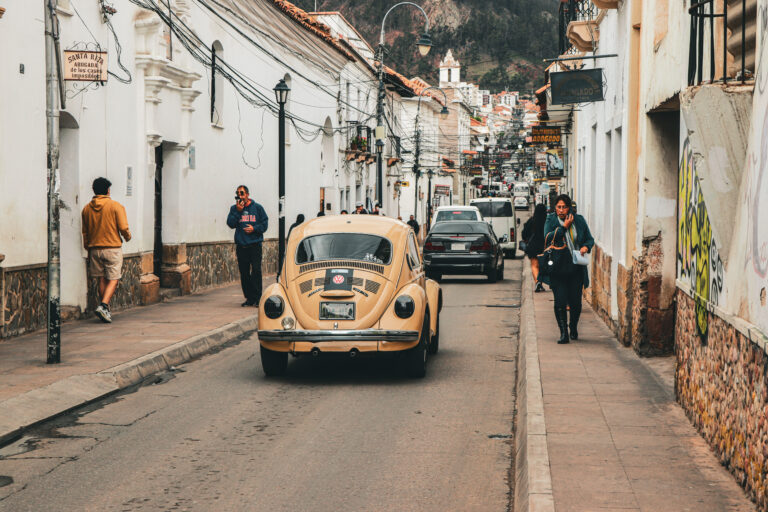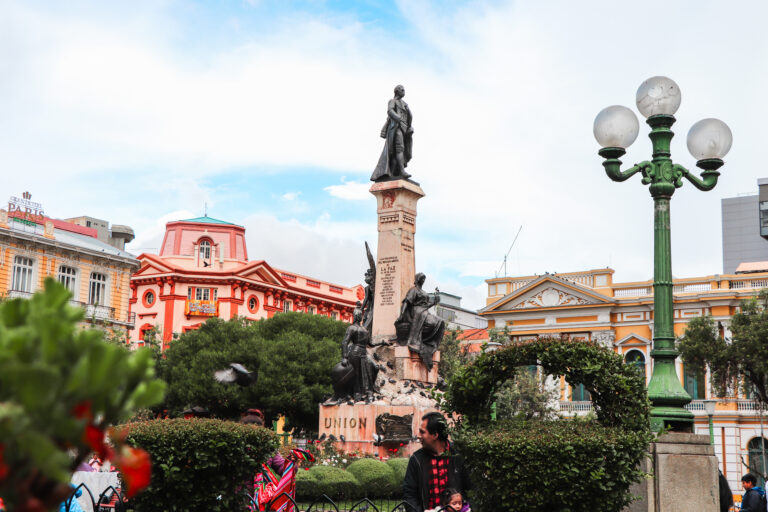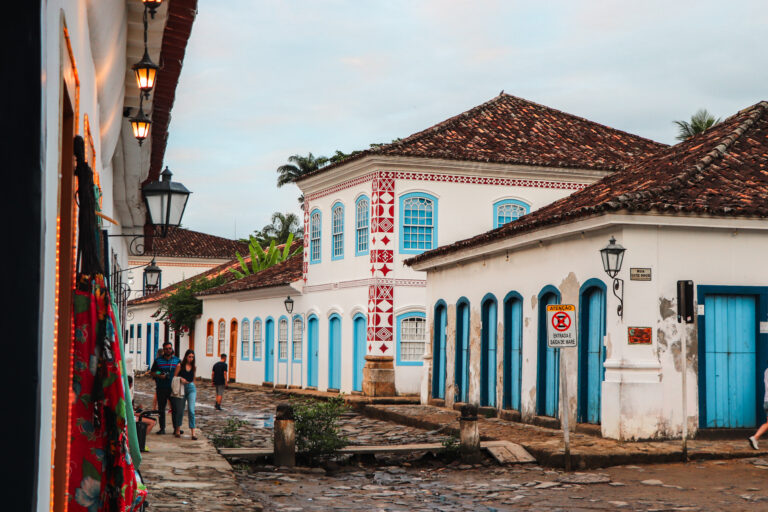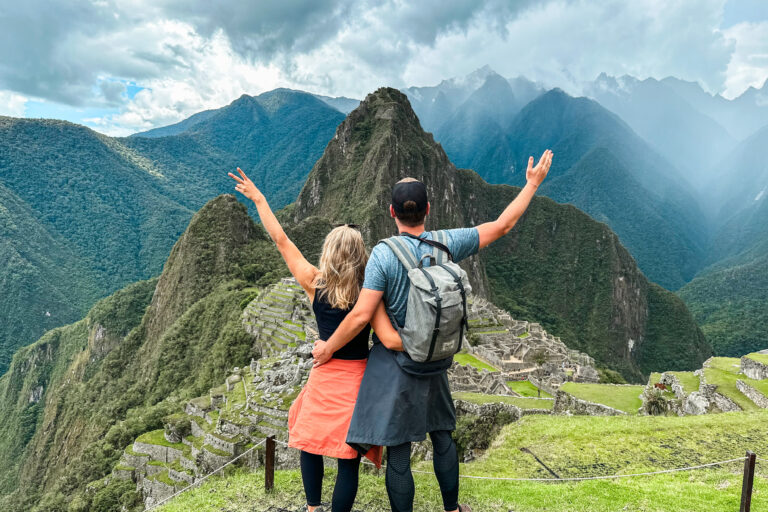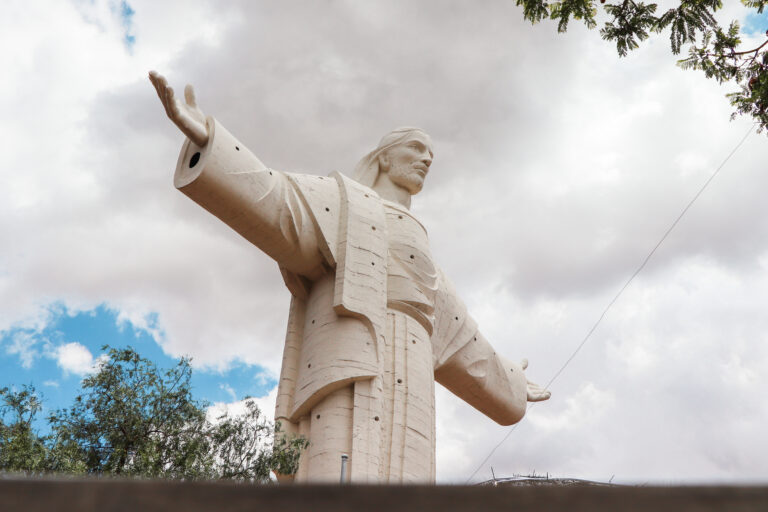Puno is the unofficial folkloric capital of Peru, but for most travelers only a transit city on their way from Peru to Bolivia. During our trip around South America, spent a few days in Puno to visit it’s famos floating islands.
With this article, we want to show you why it’s worth to spend at least two days in this small Peruvian city at the lake Titicaca.
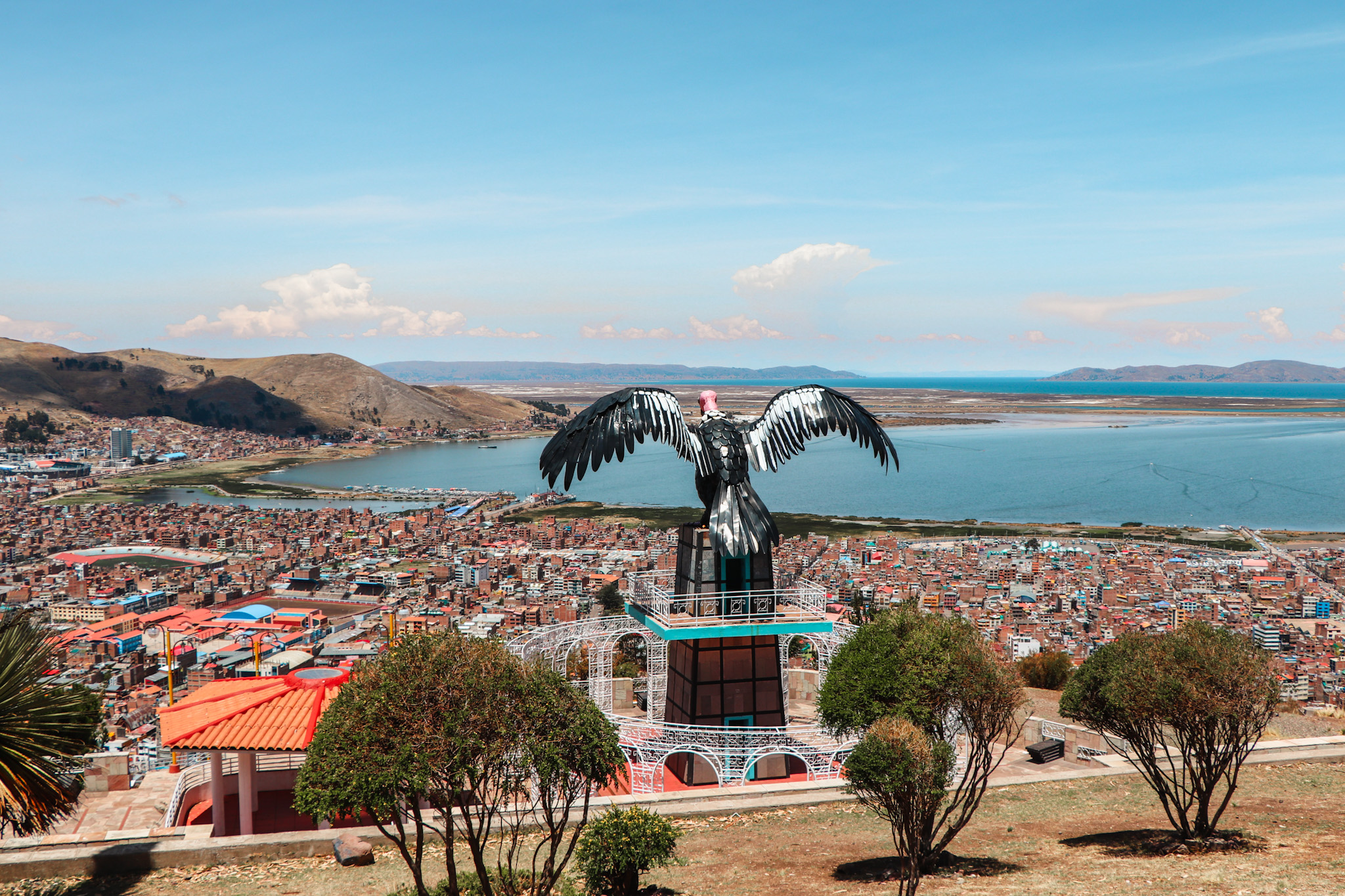
10 Best Things to Do in Puno
Puno is really an inconspicuous city. Even though it’s located next to one of the highest and largest lakes in South America, we could barely find any information about this Peruvian city.
So, we gave Puno a try and explored all of the things the city has to offer.
1. Take a Boat Ride on Lake Titicaca
Did you know that Lake Titicaca is the largest navigational lake? We didn’t, and while everything is the largest if you just be specific enough, we were blown away by the sheer size of this lake. It has waves, an endless horizon and you can’t see its end. So being in Puno is perfect to hop on a boat ride.
Boats leave at the Puno Marina (Puerto Muelle Puno) every morning. While technically you can book a boat ride at the marina, we would recommend joining an organized tour by book either through your accommodation or online.

2. Explore the Uros Floating Island
The Uros Floating Islands are man-made islands constructed on totora reeds, a native plant that grows in the lake. People here have lived over hundreds of years, even predating the Incan, and still follow the same traditions of maintaining the islands, going fishing, hoarding chickens and taking care of their simple houses to this date.
For us, it was a surreal feeling, stepping on these straw-like islands. And while we felt the water moving below our feet, we gained confidence as we’ve learned more about how the islanders construct the island. It was definitely a very fun experience that -we think- shouldn’t be missed when in Puno.



Moreover, you can choose to take a short trip around the floating island in a traditional totora reed boat for a small contribution of 10 PEN (≈ 3 USD) or choose to stay overnight on the island. We found it more fun to watch the others circling the island, but if this is something you want to experience, go for it!
At this point, we want to warn the ones among you who do not life overly touristy stuff. While you learn quite a lot on the tour, it is very salesy and not so authentic. We recommend rather taking a full day tour and also visit the Taquile island to get more out of your tour.
Book a boat tour from a local tour operator, either via your accommodation or online. We’ve taken a day trip to the Uros Floating Islands and Taquile Island with a tour operator called ‘Great Trip Peru’. The day-long tour costed 90 PEN (≈ 24 USD) per person and included the boat rides, an English-speaking guide and an (unexpectedly delicious!) meal. The Uros Floating Island are not far away from the coast and can be reached within a 30-minute boat ride.
When choosing your tour provider, try to opt for the cheapest one. Most likely, you will share the same guide with people booked with other companies, as they group the people together. Nonetheless, it was a fun and well-organized tour.
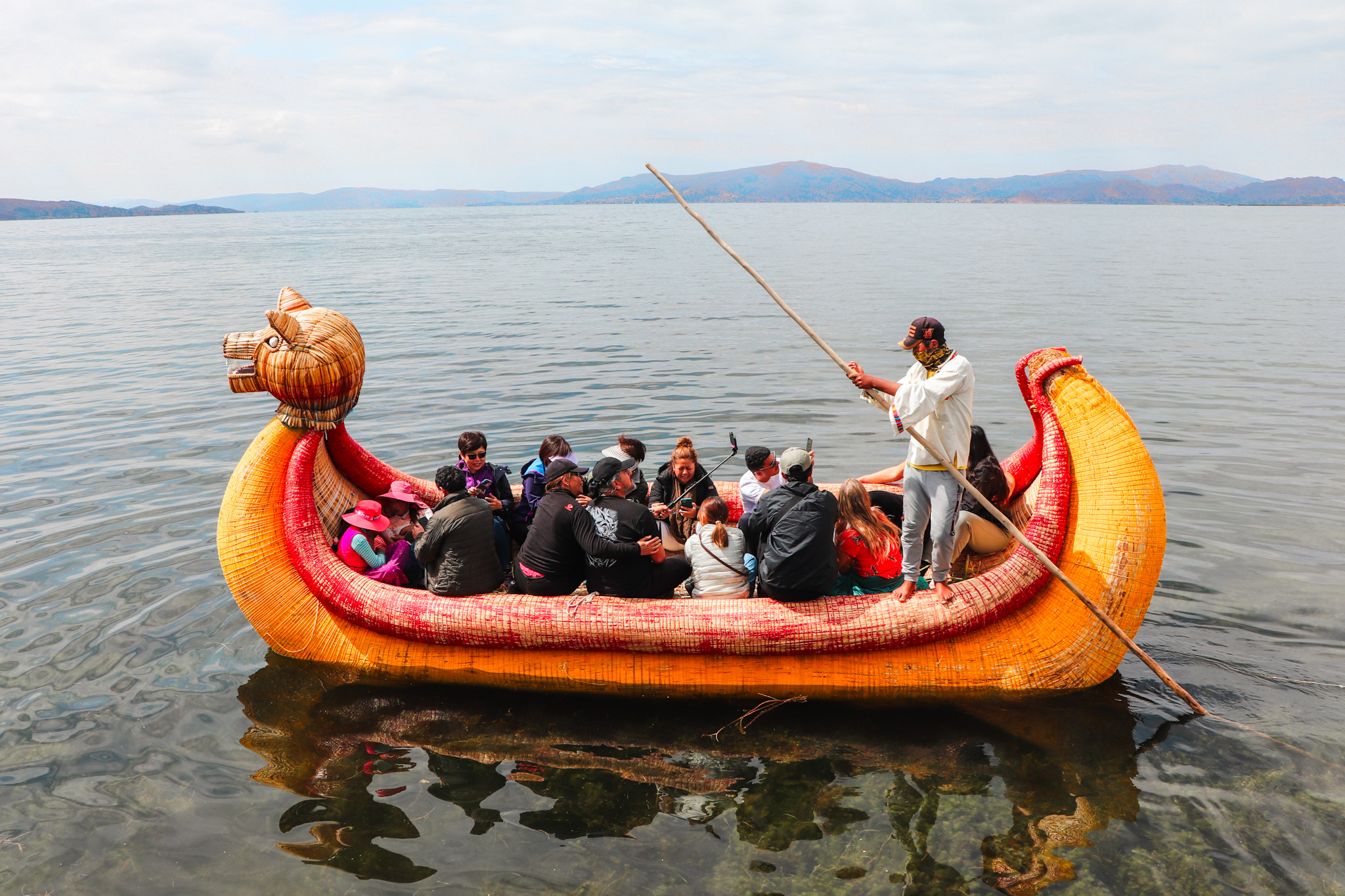
3. Visit Taquile Island
Among other traditions in Puno, Taquile Island is one of the main reasons Puno is considered the unofficial folkloric capital of Peru. This quite large island is located further inside the Lake Titicaca and is known for its beautiful traditional handicrafts. And on Taquile, it’s the men that knit and weave textile.



A boat trip to Taquile Island can be booked with most local tour operators or directly online. We’ve taken a combined daytrip to the Uros Floating Islands and Taquile Island with ‘Great Trip Peru’ for ’90’ ’PEN’. As part of the tour, you’ll have the chance to explore the island, watch the locals dance to folklore music and learn more about their remote lives.
Don’t forget to bring some water for your boat trip. Titicaca is one of the highest lakes in the world. When walking across Taquile Island you can easily get out of breath. So having enough water will come in handy.

4. Visit the main Plaza Major de Puno
One of the main plazas in Puno is the Plaza Major de Puno. It’s a beautifully decorated and well-kept square, flanked by colonial-era houses, a fountain and flower benches.
We’d say that visiting the Plaza at noon is best. Around the plaza there are a lot of good restaurants and cafés that you can visit. If the cathedral is open, take the chance to go inside and see the beautiful interior. Also, there is an ATM nearby, in case you are looking to stock up on cash.

5. Cathedral of Puno
In the city center of Puno, right next to the Plaza Major, you will find the Cathedral Basilica San Carlos Borromeo. It’s a beautiful Catholic church built in 1757 that has two impressive bell towers. The inside has an intricate design and features stone carvings, golden ornaments and a pristine marble altar.
Entrance to the church and bell tower is free. Opening times are a little tricky, as we found the church to be closed several times. Your best chances to see the inside would be in the early morning to noon.
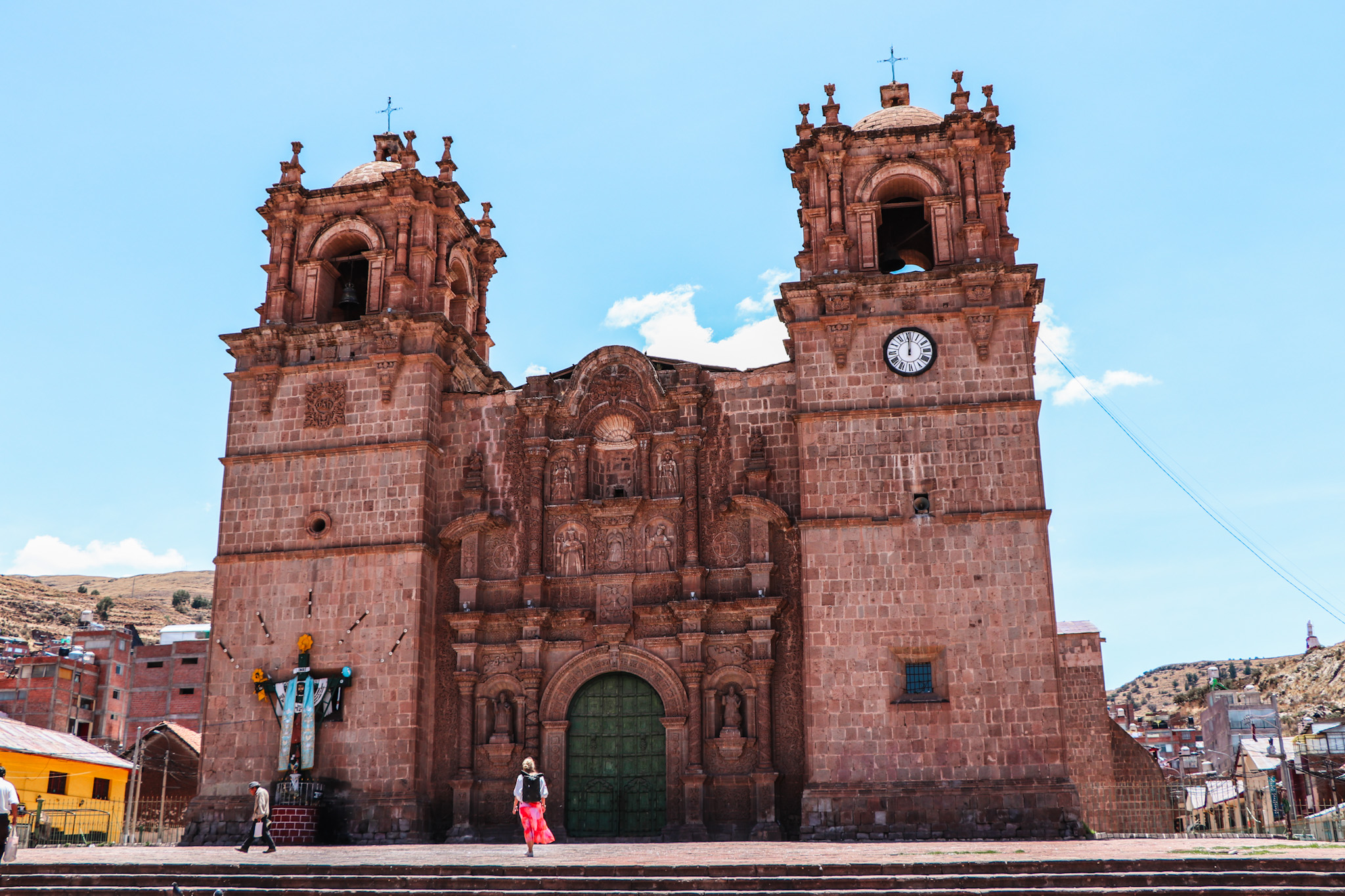
6. La Casa Del Corregidor
Next to the Plaza Major de Puno and the cathedral you can find the Casa Del Corregidor, one of the oldest colonial houses in Puno. La Casa Del Corregidor was built in 1668 and has noticeable Spanish influences. It’s sunshine-yellow color and lake-blue balconies make La Casa Del Corregidor stand out.
Though, if we hadn’t read about it beforehand, we would have easily missed this inconspicuous building.
Don’t miss the little café inside. The coffee tastes great and -if you are a digital nomad- it’s a perfect spot to surf & charge your electronics, while enjoying the relaxed atmosphere in the backyard of the plaza.


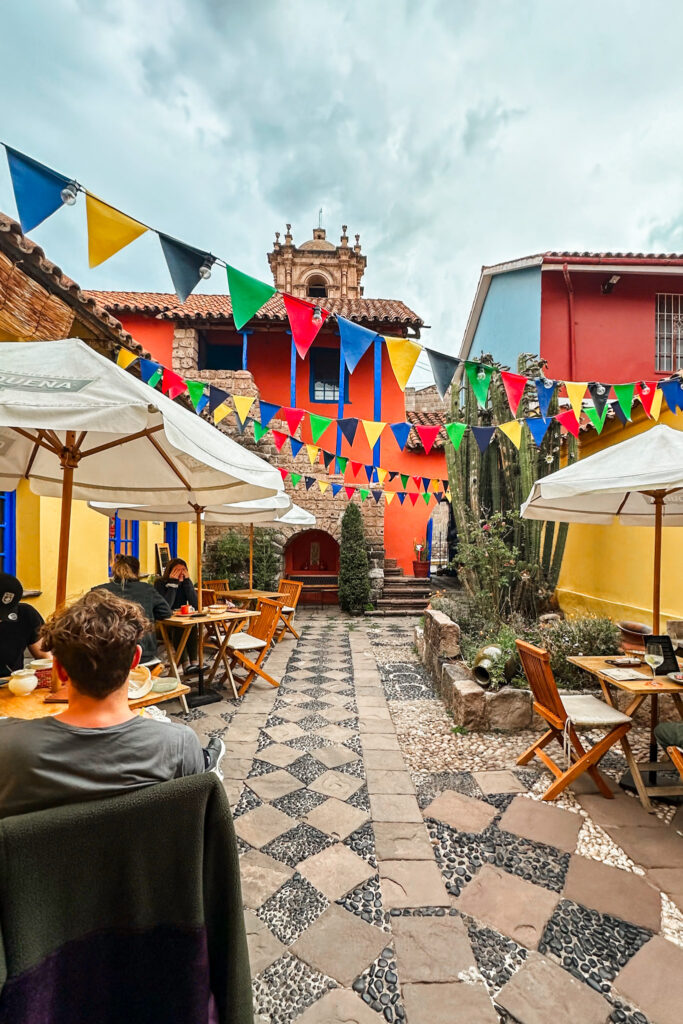
7. Stroll through Parque Pino
Visit the Parque Pino, a very charming Plaza in the heart of Puno. Compared to other Plazas across Peru, it’s a quite new plaza that was built in the 20th century.
When we visited the Parque Pino, we loved that it’s so colorful and, because of that, stands out of the often-dull streets of Puno. The plaza is surrounded by the city’s municipal building and its monument statue features Dr. Manuel Pino, a war hero who perished during the War of the Pacific.
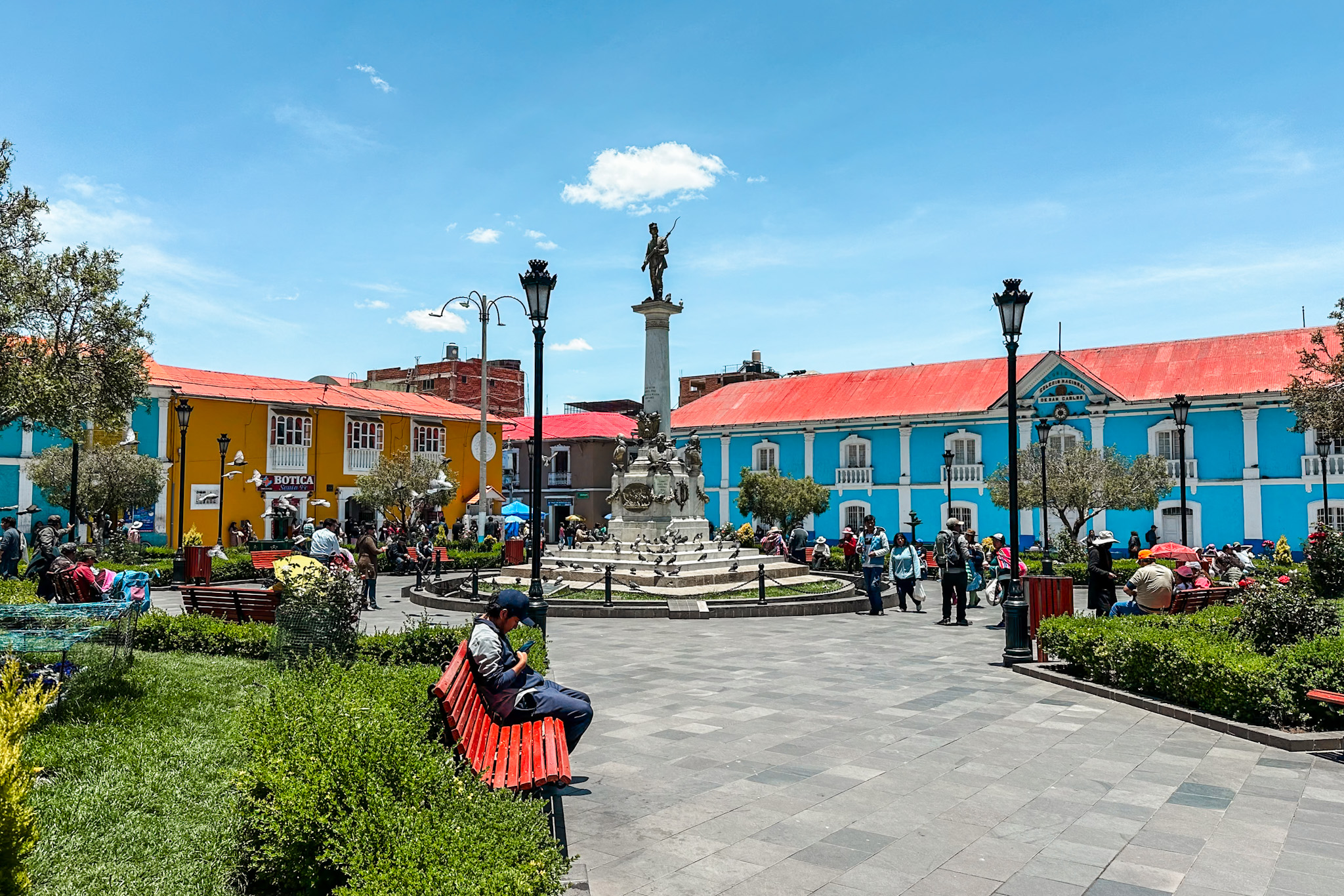
8. Hike to the Condor Viewpoint
Condors are undeniably related to Peru, as lions are to Africa or the sphinx to Egypt. Condors are not only the largest birds on earth, but also only live in high altitudes.
Maybe for that reason, Puno has built a massive Condor statue on the top of the nearby mountain overlooking the city. From there you can have an unmatched view on the city, lake and the surrounding landscape. Hiking to the Mirador El Condor (or Mirador de Kuntur Wasi) is a perfect thing to do when in Puno. And it’s also not too hard. While other cities have convenient cable cars, you’ll need to walk to the Condor Viewpoint by yourself.
Hiking up to the Condor Viewpoint from the city center of Puno takes around an hour, depending on your fitness. It’s free to enter.
If you decide to challenge the Condor View Point, take a lot of water with you to stay hydrated. Throughout the path to the top, you will need to take a lot of stairs. Luckily also a lot of benches are place along the way up to take a rest.
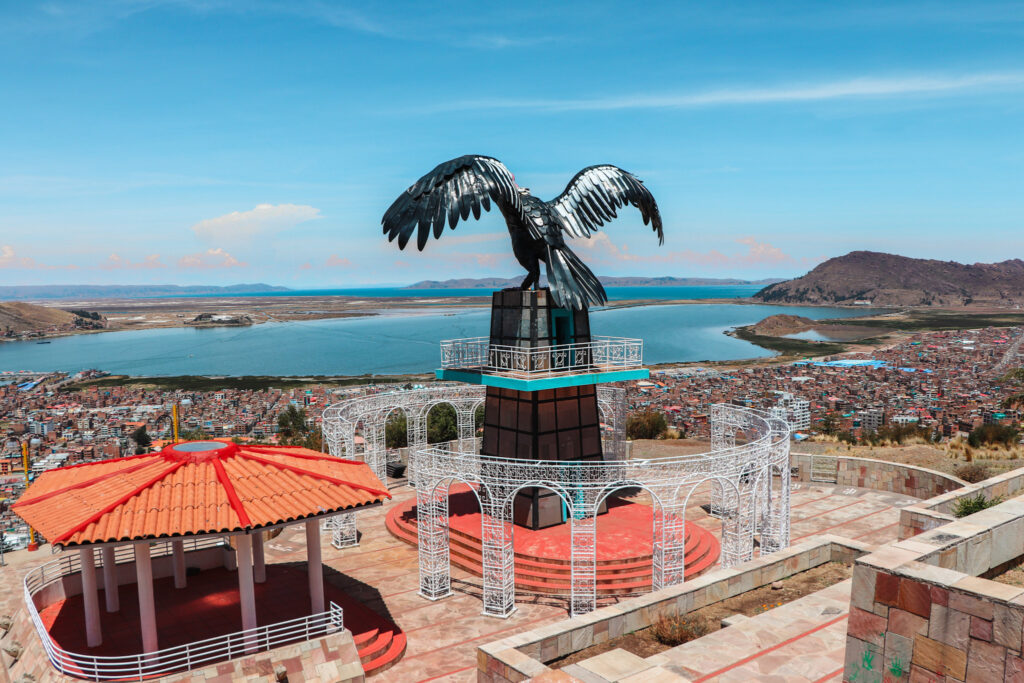
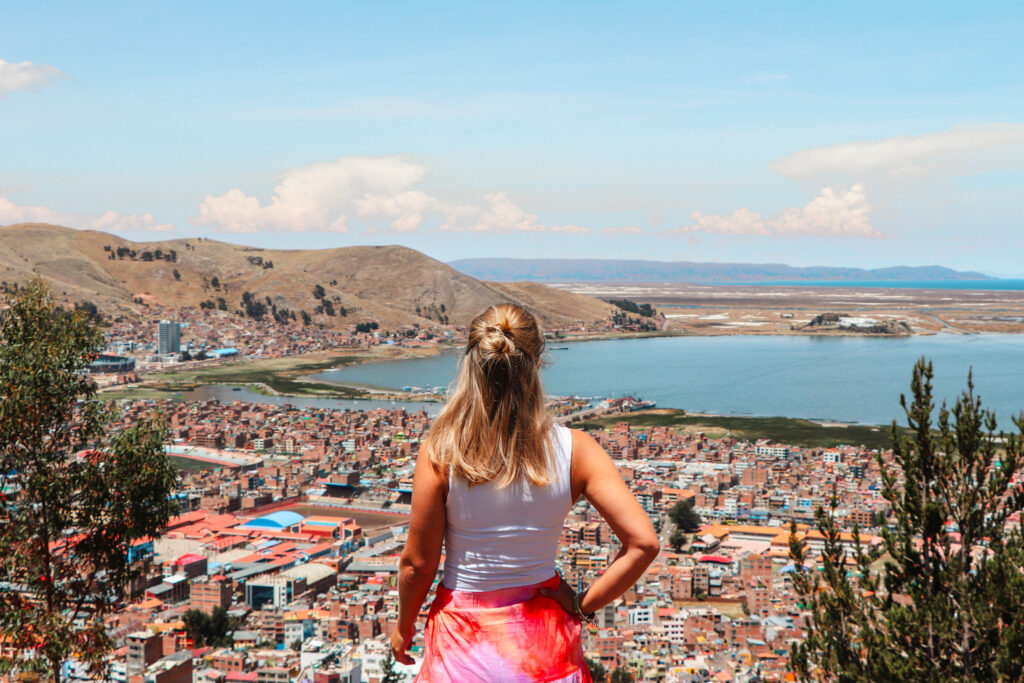
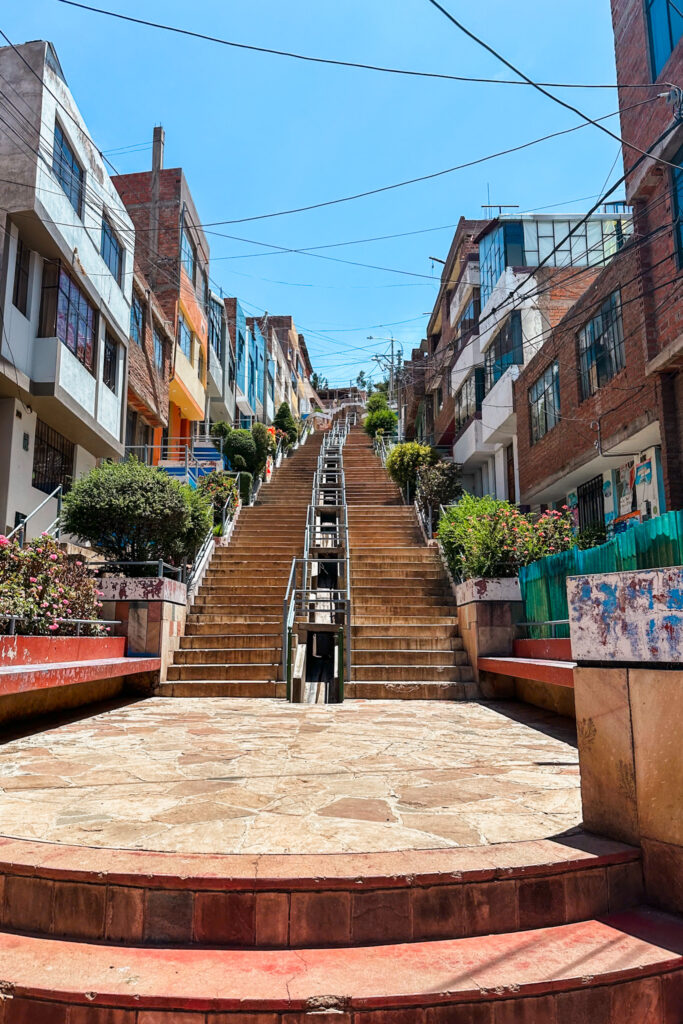
9. Shop some local handicrafts
If you haven’t had the chance to buy some souvenirs from the locals on Taquile Island, visiting some local handicraft stores in the city is another good option. After being in Cusco, we found the prices for local art in Puno much cheaper and not a little less beautiful.
Puno has a nice shopping street, close to the Parque Pino. It’s best to check it out the day you explore the city, the cathedral and the plazas.

10. Try some delicious local food
While large-scale commercial fishing is forbidden at Lake Titicaca, locals are allowed to fish for their own (and your) supply. Try out some of the local trucha (trout) in Puno’s restaurants and couple it with a Quinoa soup. It’s simply delicious!
Most recommendable restaurants are located the Plaza Major de Puno and the Parque Pino. Have a look into our ‘Where to eat in Puno’ section for some good restaurants.
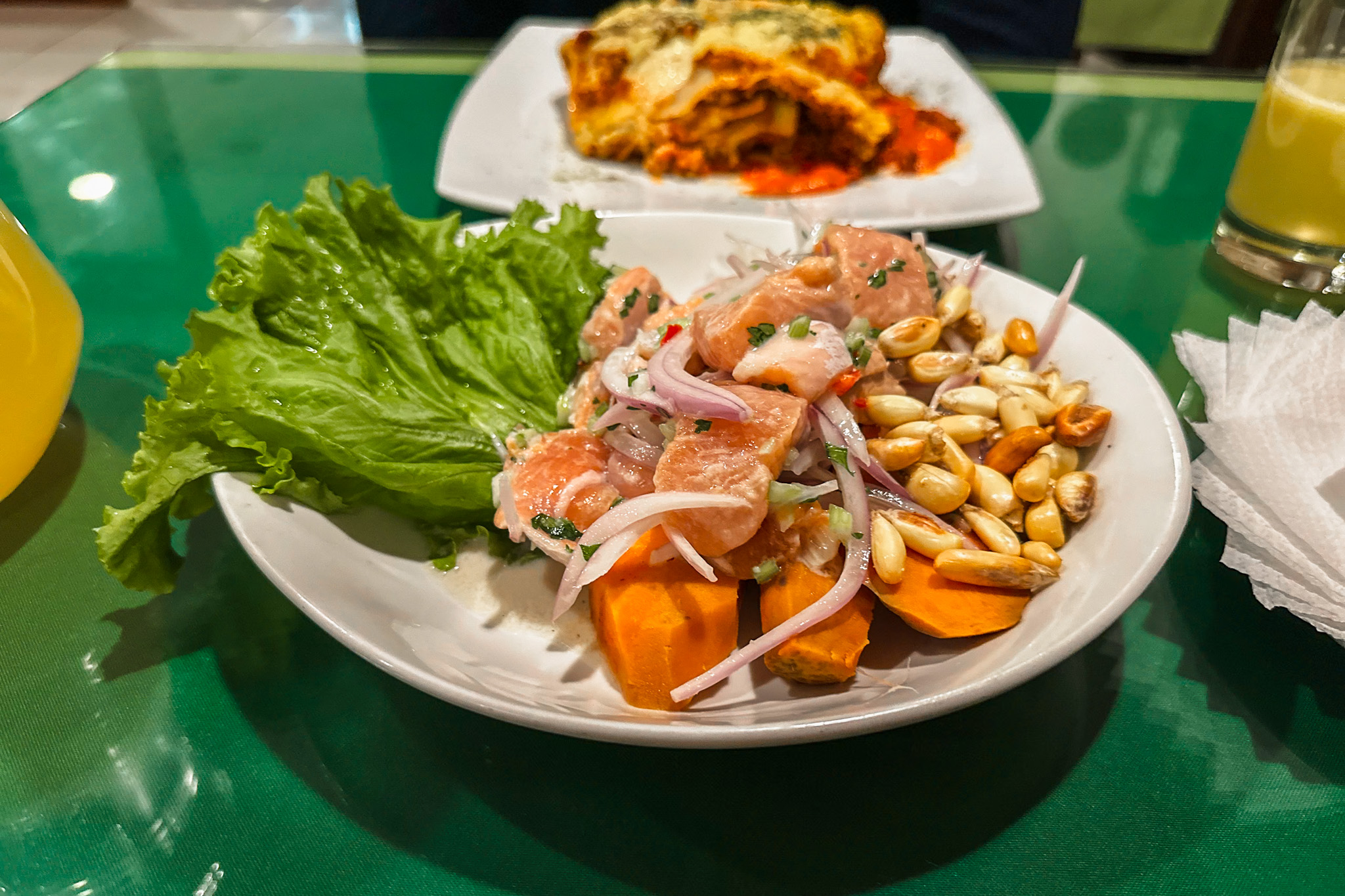
How to get to Puno?
Puno is located at the coast of Lake Titicaca in the South-East of Peru, not far away from Arequipa, Juliaca and Cusco. The city is close to the Bolivian Border, which makes it an ideal transit location for everyone heading in or out of the country.
You can get to Puno by a taking a plane to Juliaca, a bus from Arequipa and Cusco or a train from Cusco. Hopping on a bus is the most common way to reach Puno, so we listed you the most popular bus routes.
In case you didn’t know, there is a very convenient alternative to avoid the hassle of booking your bus tickets every time you reach a new destination in Peru. Peru Hop offers a comprehensive journey ticket to travel through Peru along the most popular tourist stops, including Puno.

Peru Hop is a great alternative to booking single trip tickets for all your stops. Check out their journey ticket that covers all of the popular Peru stops in one ticket!
Wear some layers of clothes. Bus rides in Peru can get freezingly cold, as some drivers turn the air-conditioning to the maximum.
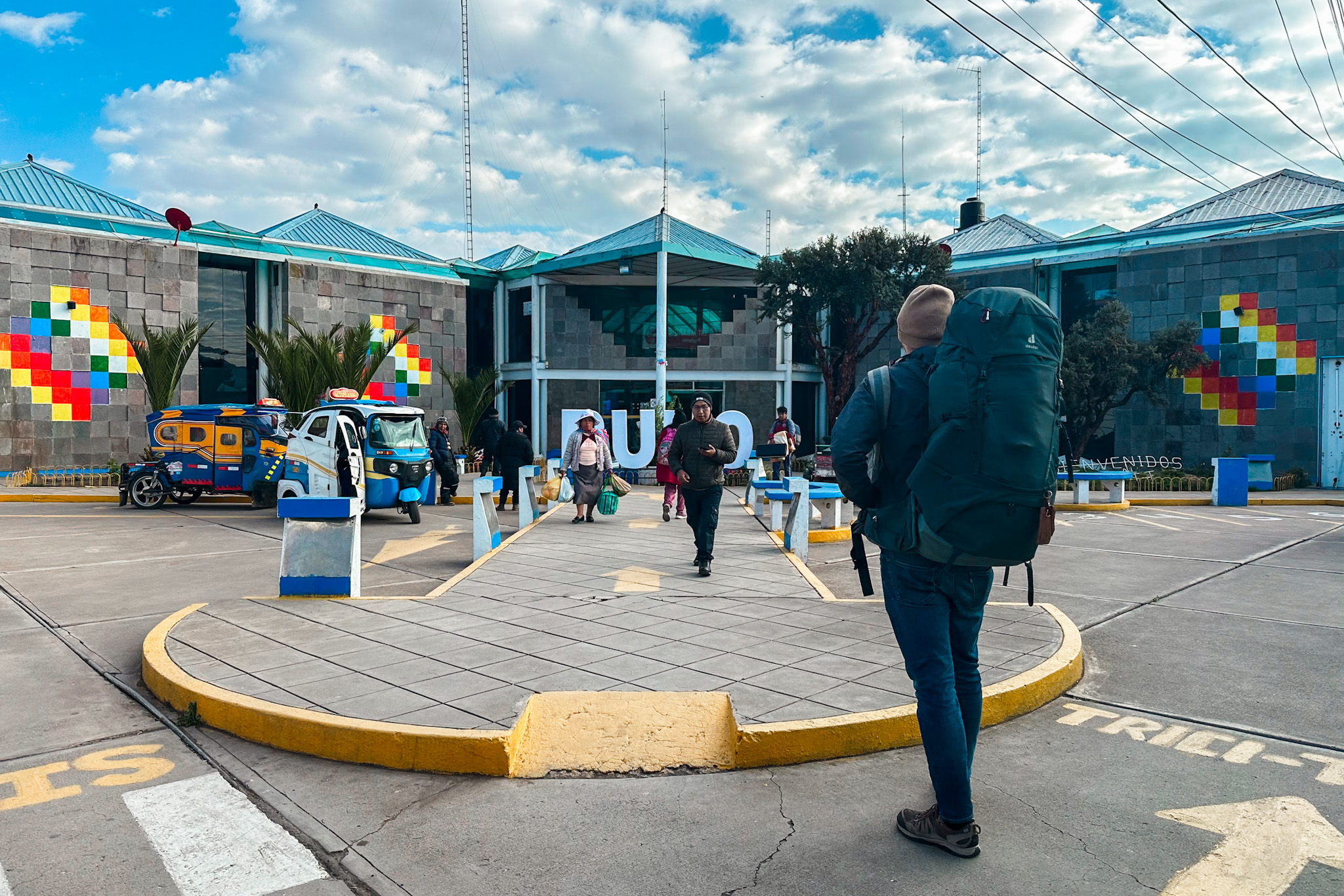
From Cusco to Puno by bus
Taking the bus from Cusco to Puno is the common route travelers take when planning to visit Bolivia after their trip through Peru. The bus ride from Cusco to Puno takes around 7.5 hours and two major bus companies (Cruz del Sur and Transzela) operate between both cities. While there are options to take the ride during the day, we opted for the night bus and would recommend you do the same.
In Cusco, buses leave from different locations, as some companies have their own terminals. Make sure to check the departure point, when booking the ticket. Buses from Cruz del Sur depart from here, while the Transzela buses depart from here.
To get to the terminal, simply take an Uber or order a taxi from your accommodation.
Relevant Reading
From Arequipa to Puno by bus
When planning to go to Bolivia from Arequipa, you’ll come across two options: Flying from Arequipa to La Paz or taking two bus rides from Arequipa to Copacabana. If you decide to travel by bus, you’ll most probably pass through Puno to change buses.
The bus ride from Arequipa to Puno takes around 5.5 hours and two major bus companies (Cruz del Sure and Transzela) operate between both cities. Most buses leave Arequipa at night, so be prepared for an overnight trip.
As for other major cities in Peru, in Arequipa, buses may leave from different locations. While most buses leave from the Terminal Terrestre de Arequipa, some bus companies do have own terminals. So, make sure to double-check your departure point.
To get to the terminal, simply take an Uber or order a taxi from your accommodations. Both options are readily available in Arequipa.
Relevant Reading
From Copacabana to Puno by bus
If you are in Copacabana in Bolivia and want to cross borders to Peru, then taking the bus is the best option. There are two major companies (Titicaca Tourist Transportation and Transzela) operating between Puno and Copacabana. Both assist you at the border to get your passport stamp and registration done.
The bus ride from Copacabana to Puno is short and takes around 2.5 hours, plus around 0.5 – 1 hour to cross the border (depending on how busy it is at the border). The buses from Copacabana leave at the main street (Av. 16 de Juli, near the Plaza Sucre) and arrive at the Terminal Terrestre de Puno.
Buses usually leave early in the morning, so make sure to check their schedules online. To book your ticket you could either choose to buy it online or walk in the companies office directly. The ticket costs around 15 – 20 USD.
Relevant Reading
Where to stay in Puno?
There are a lot of places and options to stay in Puno. But because Puno is way less popular among tourists, compared to major cities like Cusco or Lima, accommodations are rather simple and basic. The upside, however, is that it’s really affordable.
We’ve listed some of our favorite options for all types of travelers, as well as the place where we’ve stayed during our week in Puno.
Where to eat in Puno?
We’ve had great meals in Puno, but those are hard to find. We’ve read reviews about the food quality of Puno being very bad. While that may scare off people (and it also scared us), we found some nice options. Just don’t order a pizza in Puno, you won’t find a single place that makes decent Italian cuisine all over the city.
Here are three of the restaurants we’ve visited during our time in Puno.
La Casa Corregidor
- International
- Budget
Iconic Café near the Plaza Major de Puno in the oldest colonial city building La Casa Corregidor. Affordable prices, good burgers and an ideal plance to relax after your city trip.
La Estancia Grill
- Peruvian
- Moderate
When we were at La Estancia, we were blown away by the sheer size of the delicious grill plate. Go there, if you are really hunger. Meat is well cooked and tender.
Traditiciones del Lago
- Peruvian
- Budget
Try some of the traditional dishes such as lomo saltado, cuy (guinea pig), alpaca or the local trout. As the name implies, Tradiciones del Lago offers authentic Peruvian cuisine.
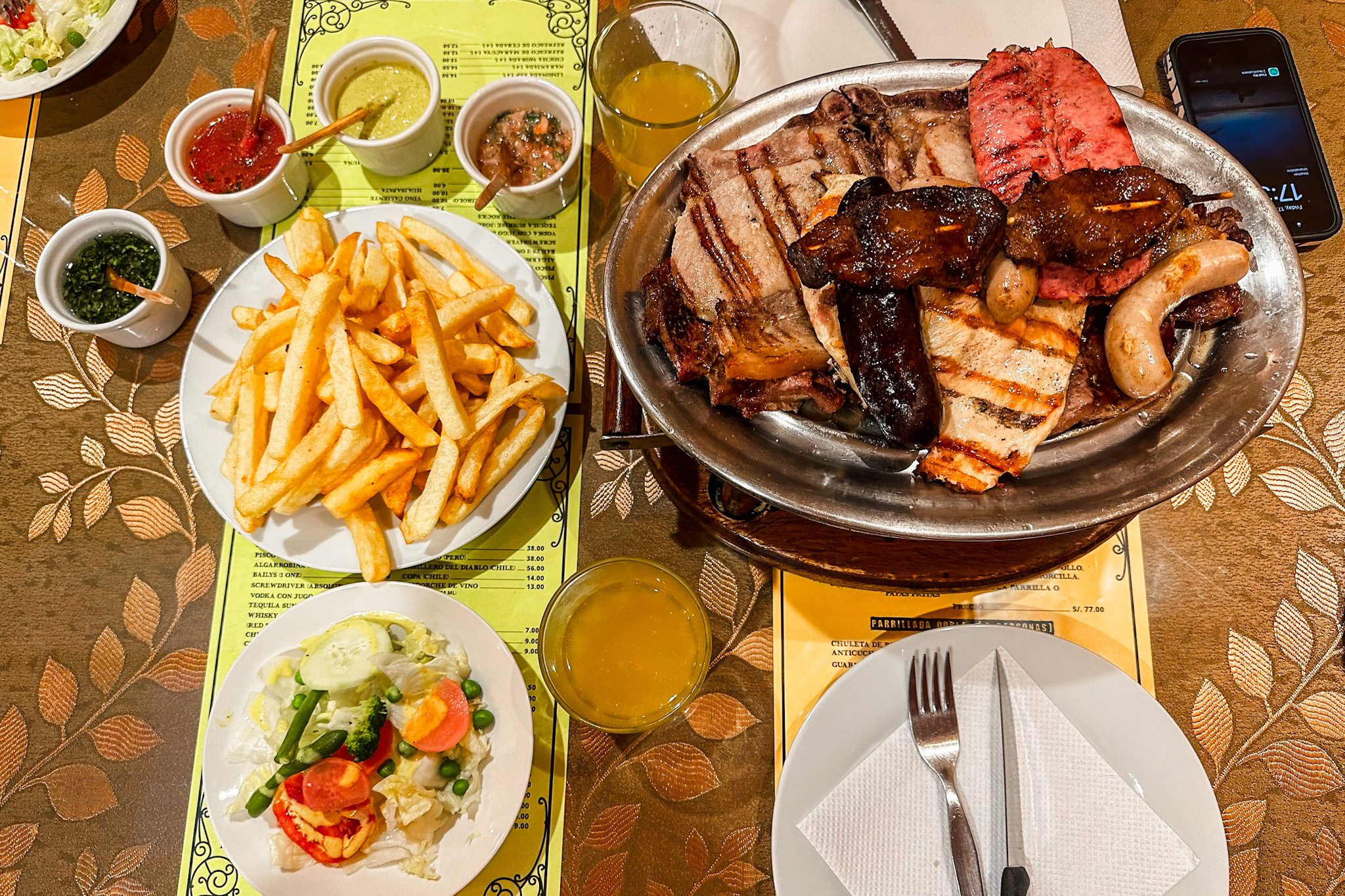
How to get around Puno?
Getting around Puno can be easily done on foot, as most of the best things to see are in the city center.
If you choose to take a boat ride, tour operators will pick you up at your accommodation to bring you to the pier. At the bus terminal, taxi drivers will wait for you to get to the center, so there is no need to book a taxi in advance. The fare for a taxi from or to the bus terminal to the Puno city center costs around 10 PEN (≈ 3 USD) to 15 PEN (≈ 4 USD).
Ask your accommodation to call you a taxi, if you decide to go to more remote places. Taxis are not metered, but their fare is cheap. Just make sure to fix a price before the ride.
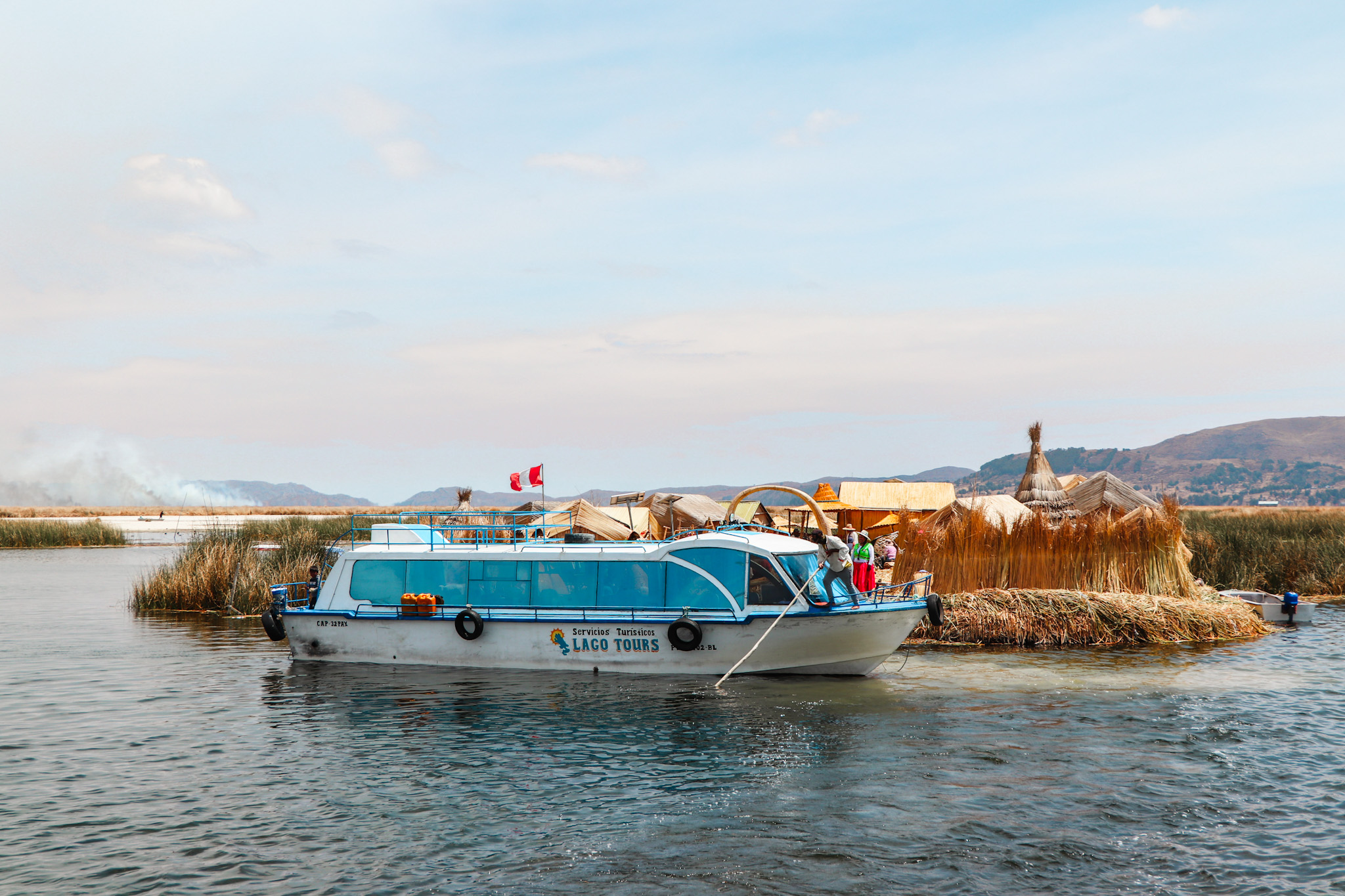
When is the best time to visit Puno?
The best time to visit Puno is between May and August, when precipitation is the lowest and the skies are the clearest. During this time weather conditions are ideal for daytrips on Lake Titicaca or hiking up the nearby mountains.
Over the year, temperatures in Puno usually vary around the 15°C mark, so it’s best to bring some layers of clothes. Even though it’s cold, don’t forget to apply a lot of sun protection. Due to the high altitude of Puno at around 3,827 meters (12,556 feet), there is an extreme level of UV. And speaking out of experience, you’ll not feel it until you’re sunburned.
If you’re brave enough, take your swimwear with you. On Taquile Island there are some nice beaches where you can prove that you’re actually an Antarctician. Nonetheless, here are the average maximum temperatures for Puno throughout the year.
What does it cost to visit Puno?
Puno is one of the most affordable cities in Peru, as most tourists only transit in Puno and switch buses to head to Bolivia or into Peru.
We’ve crunched our numbers and came up with an approximate estimate for your time in Puno. Expect to pay around 30 USD per day for a budget trip to around 170 USD if you seek a little more luxury.
How many days to stay in Puno?
If you’re not yet used to the heights of Peru, take your arrival day to acclimatize to the high altitudes. While Puno looks like a coastal town, it actually sits at a staggering 3,827 meters (12,556 feet) above sea level. Take it easy, drink a lot of water and try out the local cocoa tea or sweets.
On your first day, take a boat tour on the Lake Titicaca and visit the Uros Floating Islands and Taquile. Dine in one of the delicious local restaurants in the city or spend the night shopping for authentic crafts in the main street of Puno.
Take a walk through the city on your second day and visit the Parque Pino, the Cathedral of Puno and the Plaza Major. Think about hiking to the Condor Viewpoint in the afternoon. From up there, you’ll have a great view on Puno, Lake Titicaca and can watch the city life from above.
Relevant Reading
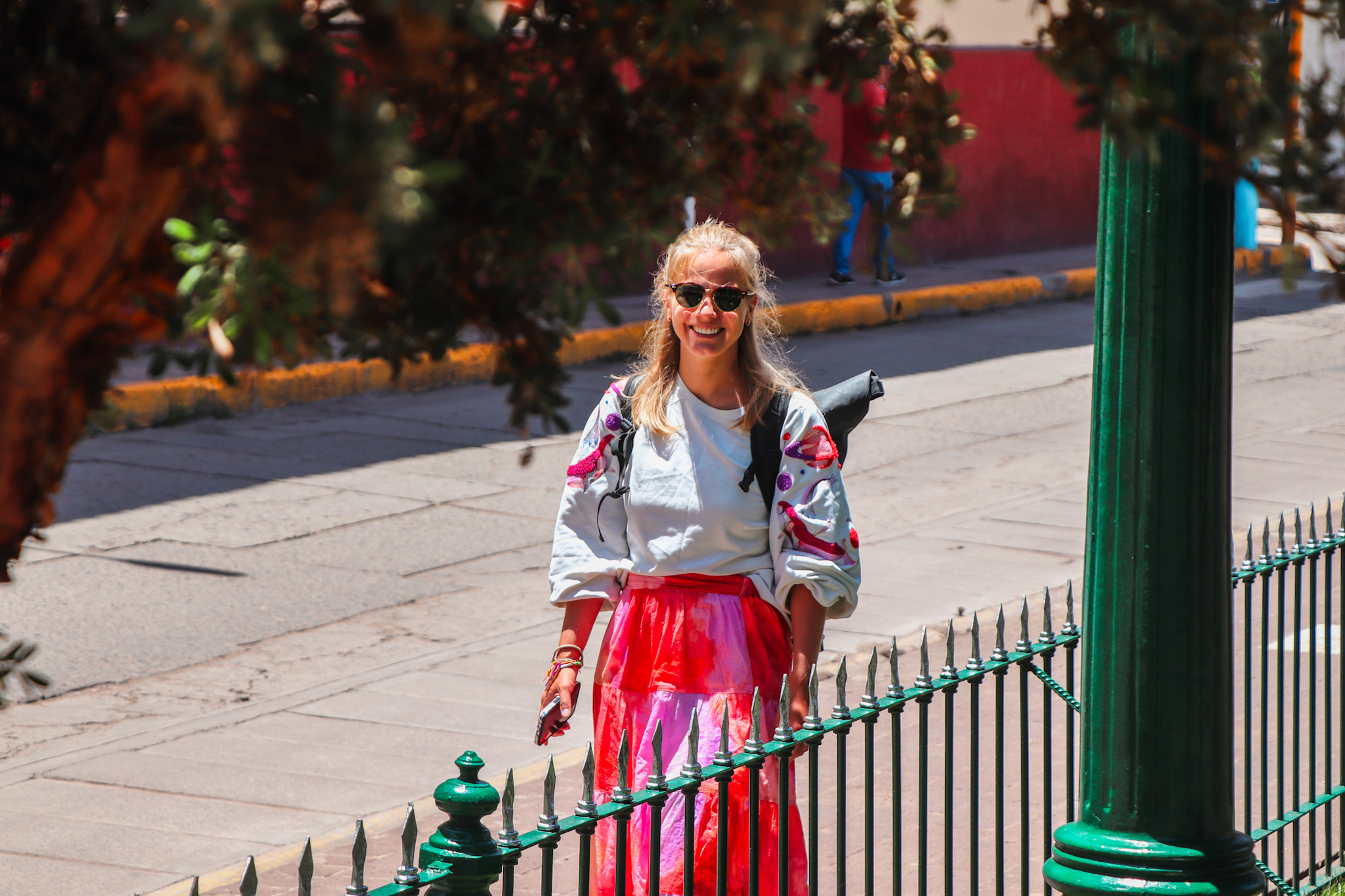
Is Puno safe to visit?
When we visited Puno, we felt very safe. We know that feeling safe and being safe are two totally different things, and while everyone can be in the wrong place at the wrong time almost everywhere on earth, we consider Puno to be a very safe city.
Locals were always very welcoming and helpful, greeted us on in the streets and police was strategically positioned throughout the city center.
Always take standard safety precautions. Don’t walk through empty streets at night, take as little money as necessary with you and leave other valuables in your accommodation.
Is Puno worth visiting?
We found Puno to be worth visiting. While it is not the most beautiful city in Peru, we had a great time there for two reasons: Firstly, we found the city to be very authentic, which was a welcomed change to the overly touristy streets of Cusco. And secondly, we had so much fun exploring the islands on the largest lake in South America.
While we don’t think Puno is a must-visit when you only have limited time (there is so much more to see in Peru!), we think it should belong on every backpacker’s Peru itinerary

